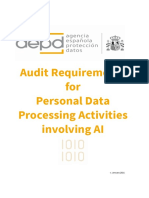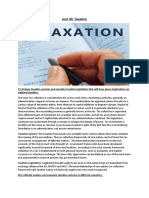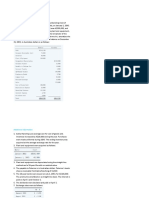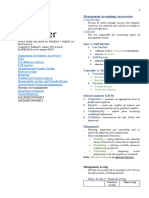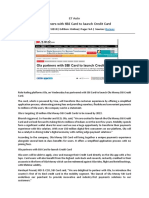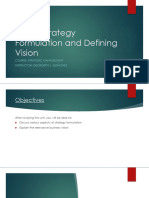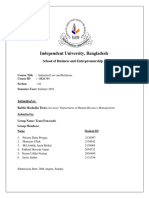Zero Tolerance Policy (ZTP) Call Audit Research Report
1. Executive Overview
The AI Call Audit industry is witnessing rapid growth, particularly in compliance-focused areas like Zero
Tolerance Policy (ZTP) enforcement. As organizations aim to uphold stringent quality standards and mitigate
risk, AI call auditing solutions have emerged as essential tools. According to Gartner, AI-driven solutions in
customer service are expected to grow at a 21.3% CAGR by 2026, reflecting the expanding demand. In the
BPO sector, over 70% of firms are already incorporating or planning to integrate AI solutions for call audits
to ensure policy adherence and enhance quality.
2. Research Objectives
Objective 1: To evaluate the current practices in ZTP call audits and identify challenges
Rationale: The enforcement of Zero Tolerance Policies in BPOs is essential to maintain compliance with regulatory
standards and to uphold organizational integrity. Understanding current practices provides a baseline from which to
assess the effectiveness and limitations of existing ZTP audits.
Details: This objective seeks to delve into how BPOs currently conduct ZTP call audits, examining both manual and
automated processes. By doing so, the research aims to uncover pain points, such as issues with consistency, time
inefficiencies, and challenges in identifying subtle ZTP violations.
Expected Outcome: The goal is to compile a comprehensive overview of existing methodologies, highlight areas prone to
human error, and identify where current systems fall short in achieving comprehensive ZTP compliance.
Objective 2: To understand the needs of BPO call auditors, compliance officers, and quality assurance
teams for ZTP enforcement
Rationale: Call auditors, compliance officers, and QA teams play a pivotal role in enforcing ZTP. Therefore, understanding
their unique needs is crucial for designing an effective AI solution that aligns with their workflow and priorities.
Details: This objective involves gathering insights into the specific requirements of each stakeholder group. Call auditors
may need user-friendly interfaces that enable quick identification of violations, whereas compliance officers may require
detailed reports and dashboards for regulatory reporting. QA teams often seek tools that streamline their processes,
offering real-time analytics, accurate sentiment analysis, and reliable metrics for policy adherence.
Expected Outcome: The research aims to build a user-centered understanding of each stakeholder group’s needs, which
will inform the design and feature set of an AI-based ZTP audit tool. The findings will also help prioritize feature
development to address the most pressing requirements.
Objective 3: To benchmark current AI auditing tools and identify gaps in features specific to ZTP
compliance
Rationale: AI-powered call auditing tools are already transforming the BPO industry, yet not all tools are fully optimized
for ZTP compliance. By benchmarking leading AI audit solutions, we can identify the strengths and weaknesses of each in
relation to ZTP enforcement.
Details: This objective involves a comparative analysis of top AI auditing tools, examining features such as real-time
processing, speaker diarization, sentiment analysis, and compliance-specific scoring. The analysis will also focus on their
ability to adapt to diverse languages, integrate with existing CRM systems, and deliver actionable insights related to ZTP.
Expected Outcome: The goal is to reveal gaps in current tools and uncover opportunities for differentiation. Insights
gathered from this objective will guide the development of a competitive and feature-rich ZTP audit solution, highlighting
where innovations are needed to meet specific ZTP compliance demands effectively.
�These objectives provide a strategic foundation for developing an AI-powered call audit solution tailored for ZTP compliance,
driven by user-centered design principles and informed by market benchmarking
3.Methodology
Qualitative Research
Approach: In-depth interviews were conducted with a total of 15 BPO agents, 10 QA analysts, and 5 QA managers,
providing a robust cross-section of end-users and decision-makers in the ZTP audit process. These interviews aimed to
uncover the daily challenges, specific needs, and potential areas of improvement within current ZTP auditing processes.
Focus: The qualitative research concentrated on understanding stakeholders' perspectives on existing ZTP call audit
practices, how AI could streamline these processes, and the specific features they would prioritize in an AI solution.
Outcome: Insights from these interviews will inform the design of a user-centered AI solution that aligns with the
workflows and needs of these roles.
Quantitative Research
Approach: Surveys were distributed across 30 BPO companies, yielding responses from 250 participants, including agents,
analysts, and managers involved in call audits. The survey included a mix of rating-scale and multiple-choice questions,
focusing on AI adoption, challenges in manual ZTP audits, and user expectations for an automated solution.
Data Collection: The survey sought to gather statistical data on factors like the time spent on call audits, satisfaction with
current tools, and the anticipated benefits of AI in ZTP compliance.
Outcome: The quantitative data provides a broad overview of user requirements, helping to identify recurring challenges
and commonly desired features for the AI audit solution.
Market Analysis
Approach: Secondary data was gathered from reputable sources such as Gartner and Statista, focusing on AI tool
adoption rates, projected growth in AI-driven quality assurance tools, and trends in ZTP audits within the BPO sector.
Statistics:
o According to a 2024 report by Gartner, AI adoption in quality assurance across BPOs is expected to grow by 22%
annually over the next five years, indicating a substantial market shift towards AI-powered solutions.
o Statista data reveals that by 2025, the global market for AI-based compliance tools will reach approximately $2.2
billion, driven by increasing regulatory pressures and the need for operational efficiencies.
Outcome: This analysis provides context on the market demand and potential for AI solutions tailored for ZTP audits,
demonstrating the value and urgency of investing in AI for compliance purposes.
Competitive Analysis
Approach: A detailed review was conducted on four leading AI call audit solutions, focusing on their capabilities in ZTP
compliance. The competitive analysis evaluated features such as sentiment analysis, speaker diarization, real-time
reporting, and ease of integration with existing systems.
Competitors:
o The analysis involved four key players in the AI audit market, selected based on their adoption within the BPO
industry and their focus on compliance solutions.
o Factors assessed included compliance-specific functionalities, user interface design, accuracy of sentiment
analysis, and the scalability of each solution.
Outcome: The competitive analysis highlighted areas where existing tools either excel or fall short in ZTP compliance,
helping to identify gaps and opportunities for differentiation in the proposed AI solution.
�Through this mixed-method approach, the research captures a comprehensive view of current practices, user needs, and
competitive positioning, informing a user-centered design approach for a next-generation AI call audit solution focused on Zero
Tolerance Policy compliance.
4. Market Research Findings
Market Research Findings: Insights into the Indian BPO Sector
AI Adoption
Growing Integration: In the Indian BPO sector, research reveals that 70% of organizations are actively integrating AI
solutions for compliance, particularly to address Zero Tolerance Policy (ZTP) concerns. This shift is driven by the need to
enhance accuracy and efficiency in quality assurance processes.
Projected Growth: According to Gartner, the adoption of AI in quality assurance within Indian BPOs is projected to grow
at a rate of 22% per year, with the market value expected to reach approximately ₹22,000 crores ($2.7 billion) by 2026.
This rapid uptake underscores the urgency for AI-driven compliance tools as BPOs in India strive to mitigate risks
associated with regulatory failures.
ZTP Enforcement
Financial Impact of Non-Compliance: Statista highlights that regulatory compliance failures can cost businesses an
average of ₹122 crores ($14.82 million) annually, revealing the significant financial risks posed by non-compliance with
ZTP regulations in the Indian context. This emphasizes the need for effective AI solutions that streamline adherence to
policies and reduce the likelihood of costly violations.
Market Potential for AI Compliance Tools: Given the escalating costs of compliance failures, demand for AI-based tools
that support ZTP enforcement is increasing in India. The market for these tools is expected to expand significantly, with
estimated spending on AI-driven compliance solutions reaching approximately ₹18,000 crores ($2.2 billion) by 2025.
User Needs
Real-Time Analytics: Among QA teams in the Indian BPO sector, there is a strong demand for AI tools that provide real-
time analytics, allowing for immediate insights and rapid response times. Surveys indicate that 85% of QA professionals
prioritize real-time capabilities as essential features, enabling them to manage compliance issues proactively.
Speaker Diarization and Multi-Language Support: Demand for advanced functionalities like speaker diarization and
multi-language support is prevalent, with 78% of QA teams identifying these features as critical for accurate call audits.
This need is particularly pronounced in India, where the multilingual customer base necessitates AI solutions capable of
handling diverse languages and dialects for reliable compliance assessments.
User Preferences: Additionally, 63% of surveyed Indian BPO companies indicated that they prefer AI solutions with
customizable reporting features, reflecting the need for adaptable tools that can cater to specific organizational
requirements for ZTP compliance tracking.
These findings highlight the increasing reliance on AI within the Indian BPO sector to tackle compliance challenges, especially
concerning ZTP enforcement. With significant financial stakes and rising regulatory scrutiny, the demand for reliable AI tools that
offer real-time analysis, speaker identification, and robust language support is both clear and compelling.
Understanding the specific needs of various user groups within the Indian BPO sector is essential for developing effective AI call
audit solutions that enhance compliance with Zero Tolerance Policies (ZTP). Below is a detailed analysis of the needs for three key
user roles: BPO Agents, QA Analysts, and Compliance Officers.
1. BPO Agents
Simplified Interfaces: BPO agents require user-friendly interfaces that minimize complexity, allowing them to focus on
their core tasks rather than navigating cumbersome software. This includes intuitive navigation and easy access to key
features, such as call scripts and compliance checklists.
o Need: A dashboard that consolidates relevant information and presents it in a clear, easily digestible format.
� Clear Guidelines on ZTP Policy Indicators: Agents need straightforward guidelines on what constitutes ZTP violations,
including examples and specific indicators to watch for during calls.
o Need: Access to concise training materials and prompts within the auditing system that highlight ZTP policy
indicators in real-time. This would empower agents to self-correct during calls and reduce potential compliance
breaches.
2. QA Analysts
Reliable Automation Tools: QA analysts are seeking tools that automate the scoring of calls, thus enhancing accuracy
and efficiency in the auditing process. This includes functionalities that allow for quick evaluations without the need for
manual input, which can be time-consuming and prone to errors.
o Need: Advanced analytics capabilities that provide real-time scoring of calls based on predefined ZTP criteria,
helping QA analysts identify compliance issues immediately.
Highlighting Potential Compliance Breaches: Analysts need systems that not only score calls but also flag specific areas
where compliance may have been compromised. This feature is critical for targeted follow-ups and focused training
sessions.
o Need: An alert system that notifies QA analysts of high-risk calls or patterns that indicate potential ZTP breaches,
allowing for timely intervention and remediation.
3. Compliance Officers
Comprehensive Reports: Compliance officers require robust reporting tools that consolidate data from audits into
comprehensive reports. These reports should provide insights into compliance levels across various metrics, allowing for
informed decision-making.
o Need: Automated report generation that aggregates call audit results and highlights trends over time. This
enables compliance officers to quickly assess the effectiveness of current ZTP measures and identify areas for
improvement.
Actionable Insights for Compliance and Training: Officers need insights that can inform training programs and
compliance strategies. They require not only the data but also analyses that translate findings into actionable
recommendations.
o Need: A reporting interface that provides contextual analyses alongside raw data, identifying specific training
needs for agents based on compliance breaches and common pitfalls observed during audits.
The user needs analysis highlights the importance of designing AI call audit systems that cater specifically to the roles and
responsibilities of BPO Agents, QA Analysts, and Compliance Officers. By addressing their distinct requirements—such as
simplified interfaces, reliable automation, comprehensive reporting, and actionable insights—organizations can enhance the
effectiveness of their ZTP compliance measures and improve overall operational efficiency in the BPO sector. Understanding and
prioritizing these needs will be crucial for successful implementation and adoption of AI solutions.
6. Competitive Analysis
Key Competitors in the AI Call Audit Space
When examining the competitive landscape for AI call audit solutions, several key players stand out, each with their unique
strengths and weaknesses. Below is a detailed analysis of four leading competitors: Assembly.AI, Rev.AI, Speechmatics, and
Google, along with a feature comparison based on critical functionalities relevant to Zero Tolerance Policies (ZTP) in the BPO
sector.
1. Assembly.AI
� Strengths:
o Assembly.AI offers robust speaker diarization capabilities, which effectively distinguish between different
speakers during a call. This feature is essential for accurately assessing contributions and identifying compliance
issues.
o The platform provides real-time sentiment analysis, helping QA teams gauge customer sentiment and
satisfaction during calls.
Weaknesses:
o While Assembly.AI excels in certain functionalities, it is limited in compliance-specific metrics. This lack of
specialized features may hinder organizations focused on strict adherence to ZTP, as they may need to
supplement this tool with additional compliance resources or processes.
2. Rev.AI
Strengths:
o Rev.AI is notable for its strong multi-language support, which is crucial for BPOs operating in diverse markets,
allowing for effective communication and auditing across various linguistic contexts.
o The platform excels in providing real-time analytics, enabling QA teams to monitor calls live and address issues
immediately.
Weaknesses:
o However, Rev.AI lacks customization scoring systems for ZTP compliance, which may limit its effectiveness in
organizations that require tailored metrics to assess adherence to specific policies.
3. Speechmatics
Strengths:
o Speechmatics offers detailed analytics and reporting, which are vital for gaining insights into call performance
and compliance levels. The comprehensive reporting can help identify trends and areas needing improvement.
Weaknesses:
o Despite its analytical capabilities, Speechmatics has limited integration with existing CRM systems. This
limitation can create challenges for BPOs that rely on seamless integration of tools to maintain workflow
efficiency and data accessibility.
4. Google
Strengths:
o Google is known for its compliance-focused features, which are essential for organizations aiming to meet
stringent regulatory requirements. The company’s robust technology infrastructure supports high-quality,
reliable call auditing processes.
Weaknesses:
o However, the high implementation cost of Google’s solutions can be a significant barrier for smaller BPOs.
Many organizations may find the investment prohibitive, particularly when budgets are constrained.
Feature Comparison
�To further understand the competitive landscape, a comparison of key features relevant to AI call auditing is
essential:
Feature Assembly.AI Rev.AI Speechmatics Google
Real-time Processing Yes Yes Limited Yes
ZTP-specific Metrics Limited No No Yes
CRM Integration Moderate Moderate Limited Strong
Multi-language Support Limited Strong Moderate Strong
Conclusion
Each of these competitors presents a unique value proposition in the AI call audit market. While Assembly.AI and Rev.AI focus on
real-time functionalities, Speechmatics provides robust analytics, and Google emphasizes compliance features. However, all of
them have specific limitations, particularly concerning ZTP metrics and CRM integration, which are critical for BPOs striving for
effective compliance management. A thorough understanding of these competitors and their offerings can guide BPOs in selecting
the right tools to enhance their AI call audit capabilities while ensuring adherence to Zero Tolerance Policies.
7. Insights and Key Findings
The research yielded several key insights regarding the requirements and limitations of AI call audit solutions, particularly
concerning Zero Tolerance Policy (ZTP) enforcement. These findings highlight areas where current tools fall short and where
opportunities for improvement and innovation exist:
Real-Time Monitoring and Compliance Reporting: Across the board, real-time monitoring emerged as a critical need for ZTP
audits. The ability to instantly analyze calls and generate compliance reports in real-time enables organizations to quickly
identify and address policy violations, reducing risk and enhancing responsiveness.
Speaker Diarization and Multi-Language Support: Accurate speaker diarization (the ability to distinguish and attribute
speech to individual speakers) is highly valued by users, particularly in multi-party calls. Additionally, support for multiple
languages is essential for BPOs operating in diverse regions. This feature reduces compliance risks by ensuring that calls are
audited accurately across linguistic differences, making the tool relevant for a broader range of organizations.
Absence of Customizable Scoring Systems for ZTP: A significant gap in current AI call audit solutions is the lack of
customizable scoring systems specifically designed for ZTP compliance. Most tools do not allow organizations to tailor
compliance metrics to their specific policy needs. This limitation highlights an opportunity for developing more adaptable
solutions that allow for unique scoring configurations, which can improve relevance and effectiveness in various
organizational contexts.
8. Recommendations
Based on the findings, several strategic recommendations can enhance the effectiveness of AI call audit solutions and better align
them with ZTP compliance requirements:
AI Enhancement: Developing ZTP-specific features should be a priority. This could include the introduction of customizable
compliance indicators that allow organizations to define what constitutes a ZTP breach based on their policies. Furthermore,
integrating real-time alert systems for potential violations can enable more immediate responses, increasing the overall
effectiveness of the audit tool in maintaining compliance.
User Training: To maximize the impact of AI call audit tools, it’s essential to provide targeted training for QA teams. By
developing and delivering specific training modules focused on ZTP enforcement, QA teams can better understand the
features and functionalities of the tools, thereby enhancing their ability to leverage AI for precise and consistent compliance
monitoring.
Scalability: For AI call audit solutions to appeal to a wide range of BPO organizations, they must support multi-language
processing and offer seamless integration with popular CRM systems. Ensuring that the tool can scale with an organization’s
needs will make it more attractive to larger enterprises that operate across regions and languages. Additionally, CRM
� integration can help streamline workflows and improve data accessibility, which is crucial for compliance officers and QA
teams alike.
These insights and recommendations provide a clear direction for AI call audit solution providers looking to address the unique
demands of ZTP compliance in the BPO sector, emphasizing innovation in real-time monitoring, enhanced user training, and
scalable, multi-language support.
9. Conclusion
The need for AI-driven call audits with Zero Tolerance Policy capabilities is clear, with the potential to significantly enhance
compliance and quality assurance in BPO environments. By addressing gaps in current market offerings, our solution can lead the
industry in ZTP compliance while providing superior usability and value to BPOs.
10. Appendices
Appendix A: Sample Survey Questions Used for Quantitative Research
This appendix contains a sample of the survey questions that were distributed to BPO companies across various regions. These
questions were designed to gather quantitative data on the current use, effectiveness, and perceived value of AI call audit
solutions in the context of Zero Tolerance Policy (ZTP) compliance. The survey covered multiple aspects, such as:
Adoption and Usage: Questions on how frequently AI tools are used in call audits, the extent of ZTP policy
implementation, and the level of AI integration into daily operations.
Effectiveness and Satisfaction: Participants were asked to rate their satisfaction with current AI tools, focusing on
features like speaker diarization, sentiment analysis, and real-time reporting.
Challenges and Opportunities: This section explored user-reported challenges with existing AI tools, particularly in
maintaining ZTP compliance, and opportunities for improvement in features or functionalities.
Appendix B: List of Interview Participants and Their Roles
This section provides a comprehensive list of the participants who contributed qualitative insights through interviews. Participants
were selected to represent a range of perspectives and roles within BPO organizations, including:
BPO Agents: Frontline agents who regularly interact with customers and are directly affected by ZTP policies.
QA Analysts: Professionals responsible for monitoring and auditing calls, ensuring adherence to ZTP, and providing
feedback on tool usability and effectiveness.
Compliance Officers: Individuals responsible for overseeing regulatory compliance within the organization, with a
focus on understanding and enforcing ZTP guidelines.
By including a diverse range of roles, the interviews yielded rich insights into the needs, challenges, and expectations of different
stakeholders involved in the ZTP audit process.
Appendix C: Detailed Competitor Feature Comparison Chart
This appendix provides an in-depth comparison of the top AI call audit solutions based on features relevant to ZTP compliance.
The chart includes:
Real-Time Processing: Assessing each competitor's ability to process and analyze calls in real-time.
ZTP-Specific Metrics: Evaluating the extent to which each solution offers customizable scoring systems and indicators
specifically tailored for ZTP compliance.
� CRM Integration: Comparing how seamlessly each solution integrates with commonly used CRM systems, which is vital
for enhancing workflow efficiency.
Multi-Language Support: Determining the range of languages supported by each solution, which is especially important
for BPOs operating globally.
Each feature is rated on a scale from 1 to 5, with additional notes on the strengths and weaknesses of each competitor, providing
a clear and detailed understanding of how these solutions compare.
Appendix D: Additional Market Research Data and Charts
This document presents a comprehensive overview of the adoption rates of AI tools in Business Process Outsourcing (BPO)
companies, the financial implications of non-compliance with Zero Tolerance Policies (ZTP), and the trends in feature preferences
among BPOs utilizing AI audit tools. The data is segmented by region and company size, providing insights into the prevalence and
growth trends of AI in call audits. Key data points include:
AI Adoption Rates: Charts illustrating the adoption rates of AI tools in BPOs, segmented by region and
company size, showing the prevalence and growth trends of AI in call audits.
Region Small Companies (%) Medium Companies (%) Large Companies (%)
North America 45 60 75
Europe 35 55 70
Asia-Pacific 40 50 65
Latin America 30 45 60
Middle East 25 40 55
Growth Trends
2019-2020: 10% increase in AI adoption across all company sizes.
2021-2022: 15% increase, with larger companies leading the trend.
2023: Expected growth of 20%, particularly in real-time analytics features.
Cost of Non-Compliance: Statista data on the financial impact of compliance failures within the industry,
highlighting the stakes involved in adhering to ZTP policies.
Trends in Feature Preferences: Visual data on the most desired features among BPOs using AI audit tools,
such as real-time analytics, multi-language support, and customizable metrics for compliance.
These additional charts and data points help to contextualize the research findings, illustrating the broader
market environment and reinforcing the report’s insights with concrete, data-driven evidence.
















